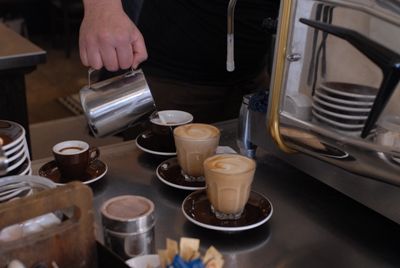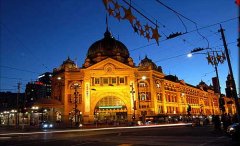"hometown of Xiaobai Coffee" Coffee Culture in New Zealand
Over the past few decades, as more and more New Zealanders love coffee and become connoisseurs of coffee, New Zealand can be said to have experienced a "coffee revolution"-a growing number of coffee lovers has spawned a fast-growing coffee industry, and new cafes and coffee roasting stores are springing up across New Zealand. The coffee industry is also a highly competitive industry-coffee owners show their own talents on how to cook the perfect cup of coffee, and coffee drinkers are becoming more and more picky about their tastes.

Must drink every day
Coffee lovers in New Zealand do not hesitate to go a long way in order to drink the indispensable coffee of the day. Their favorite cafes are also in a variety of forms, some of which are no different from humble roadside stalls, some of which are so small that they can only accommodate a high-quality coffee machine and a skilled operator, while others are fashionable places with seats as luxurious as the clubhouse, with a variety of delicacies and packages.
Cafes in New Zealand are generally happy to serve children, and many cafes offer toys, high chairs and children's drink lists. Many young mothers do their daily homework by partying with friends in local cafes, chatting over coffee while children play or indulge in New Zealand specials known as "fluffy".
In addition to being a place for social friends, New Zealand cafes can also be used as corporate meeting places and offices with wireless networks for business people with laptops.
The dispute over "Xiaobai Coffee"
New Zealand is believed to have created the first variety of "small white coffee", so it is famous in the field of coffee culture in the world. In the traditional sense, "small white coffee" refers to a brewed coffee with less milk, which uses textured milk instead of sparkling milk.
"Little White Coffee" is once again popular in Britain and the United States, not only to meet the needs of a large number of Australians and New Zealanders traveling abroad. it is also because many Australians and New Zealanders have opened cafes in cities such as London and New York.
Although there is controversy about the difference between New Zealand "Little White Coffee" and Australian "Little White Coffee", coffee experts agree that the crux of the problem is the ratio of coffee to milk.
A real "Xiaobai Coffee" should contain the same amount of coffee juice (usually 30ml) as other types of coffee drinks on the menu, but because the cup used is smaller (175ml), Xiaobai has a heavier taste than a variety of coffee such as a latte. The latte uses a 225 ml cup, so it has a stronger milk flavor.
The concentration of milk is another standard to distinguish "Xiaobai" from latte-latte milk is creamy, a fluffy layer floats above the surface, and the thickness of the milk layer varies depending on where you buy it. "Xiaobai" is sprinkled with sparse textured milk on the surface, which is ideal if the surface shines with luster.
Jay Chapman, a trainer at Mojo, a coffee monopoly in New Zealand, said that Xiaobai is definitely an Australian drink, but who invented it may be as endless as the fight between cream fruit meringue and Lamington cake.
"there is little difference in terms of production process between New Zealand rookies and Australian rookies," Chapman said. the matching principle is also the same, but the actual treatment varies, especially with different cups of different styles. "
Background: new Zealand Coffee Guide
Espresso / short black (Italian concentrate): the basis of all coffee varieties, Italian concentrated taste has the strongest aroma, mellow shape and long aftertaste, served in a small coffee cup (demi-tasse).
Macchiato (macchiato): single or double Italian concentrate, embellished with foamed milk.
Long black (Black Coffee): a single espresso concentrate, with the same amount of hot water, filled in a large cup up to the rim, sometimes served separately.
Flat white ("Xiaobai"): 1PUBG 3 Italian concentrate, 2AGU3 boiled milk, with a little whirlpool foam.
Cappuccino (cappuccino): regular espresso with the same amount of boiled milk and foam and sprinkled with chocolate or cinnamon.
Caffe latte (latte): regular Italian concentrate, topped with a layer of hot milk, with or without foam.
Mochaccino (mocacino): Italian concentrate, boiled milk and cocoa each account for 1/3.
Ristretto: 15-20ml espresso, the essence of coffee.
Piccolo latte (piccolo latte): a small latte made of Rex and 70ml boiled milk. It is a drink with delicate taste and unique flavor.
Affogato: Italian concentrate with ice cream.
Espresso Romano (Roman concentrate): Italian concentrate with lemon flavor.
Latte macchiato (latte macchiato): pour concentrated Italian boiled milk from the side.
Espresso con panna: Italian concentrate with a small amount of whipped cream.
Cortado (Gurdo): the Spanish version of the piccolo latte is packed in a 60ml small coffee cup.
Fluffy: a children's drink filled with foamed milk in a small coffee cup sprinkled with chocolate and served with marshmallows and a chocolate fish.
In addition, there is also a choice of cups, including large cups, mugs, bowls and glasses; the types of milk include whole milk, regular milk, semi-skim milk, skim milk, soy milk and the number of drinks. In this way, you can vividly outline the drink list of most cafes in New Zealand.
Important Notice :
前街咖啡 FrontStreet Coffee has moved to new addredd:
FrontStreet Coffee Address: 315,Donghua East Road,GuangZhou
Tel:020 38364473
- Prev

The mysterious History of Health Coffee
At present, coffee has become an indispensable drink in our lives, but in the long journey of looking for coffee, we seem to feel the endless romance of people's enthusiasm and adventure. In the quiet depths of the forest, how did the coffee of keeping in good health be discovered? This comes from the doctrine of Islam. In the 12th century AD, there was a famous tribal name in China.
- Next

Walk around Melbourne, the coffee capital
Summary: Melbourne's thriving coffee culture has earned it the reputation of being the coffee capital of Australia. At the edge of the city, Richmond, St Kilda, Fitzroy, South Melbourne and Prahran districts are also dotted with several famous coffee streets, each with its own characteristics. Melbourne's coffee houses are like peaceful harbors
Related
- How did the Salvadoran coffee industry develop in Central America?
- What exactly does the golden cup extraction of coffee mean?
- The Origin of Coffee flower
- [2023 Starbucks World Earth Day] there are more meaningful things besides free Starbucks coffee!
- What kind of coffee is there in Spain? 9 Flavors of Spanish Coffee
- Aromatic African coffee| Kenya's coffee culture and historical production area
- Liberica Coffee Bean knowledge: the characteristics of Liberian Coffee beans of the three original species of Coffee beans
- The origin and formula of Spanish latte introduces the taste characteristics of Bombon coffee in Valencia, Spain.
- How to adjust the solution of over-extracted coffee
- What is the tasting period of coffee beans? What is the period of coffee and beans? How should coffee wake up and raise beans?

